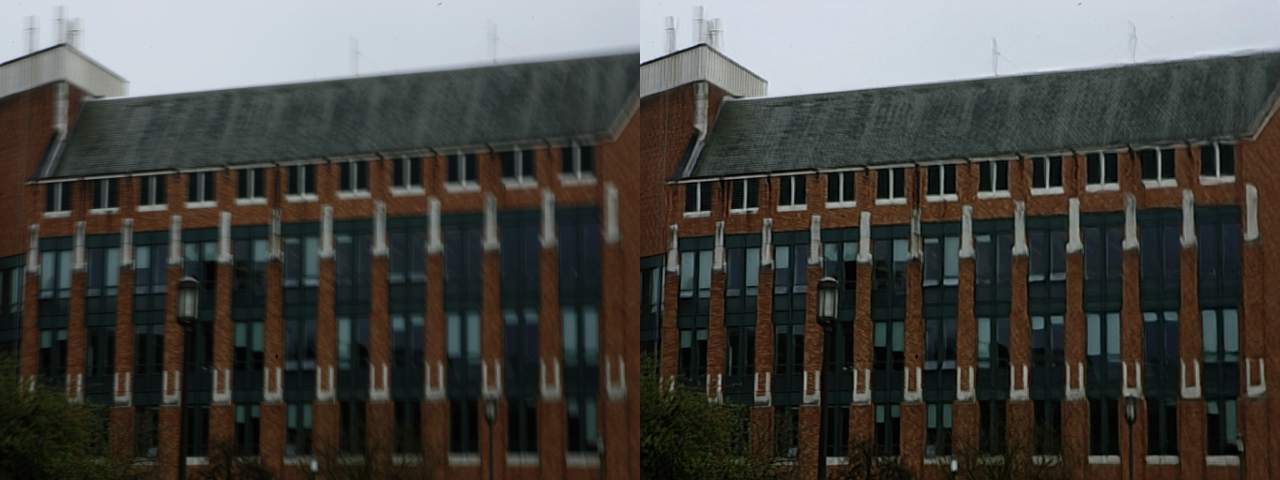
This topic demonstrates how to run the Image Deblurring demo application, which does inference using deblurring networks.
How It Works
Upon the start-up the demo application reads command line parameters and loads a network. The demo runs inference and shows results for each image captured from an input. Depending on number of inference requests processing simultaneously (-nireq parameter) the pipeline might minimize the time required to process each single image (for nireq 1) or maximize utilization of the device and overall processing performance.
For each image demo performs the following steps:
- Do preprocessing consisting of normalization and padding to input shape of model.
- Inference of model (user is able to set the inference options to influence the execution process).
- Do postprocessing for output of model.
- Display the resulting image together with source image.
NOTE: By default, Open Model Zoo demos expect input with BGR channels order. If you trained your model to work with RGB order, you need to manually rearrange the default channels order in the demo application or reconvert your model using the Model Optimizer tool with --reverse_input_channels argument specified. For more information about the argument, refer to When to Reverse Input Channels section of Converting a Model Using General Conversion Parameters.
Running
Running the application with the -h option yields the following usage message:
python3 deblurring_demo.py -h
The command yields the following usage message:
usage: deblurring_demo.py [-h] -m MODEL -i INPUT [-d DEVICE]
[-nireq NUM_INFER_REQUESTS] [-nstreams NUM_STREAMS]
[-nthreads NUM_THREADS] [--loop] [-o OUTPUT]
[-limit OUTPUT_LIMIT] [--no_show]
[-u UTILIZATION_MONITORS]
Options:
-h, --help Show this help message and exit.
-m MODEL, --model MODEL
Required. Path to an .xml file with a trained model.
-i INPUT, --input INPUT
Required. An input to process. The input must be a
single image, a folder of images or anything that
cv2.VideoCapture can process.
-d DEVICE, --device DEVICE
Optional. Specify the target device to infer on; CPU,
GPU, FPGA, HDDL or MYRIAD is acceptable. The demo will
look for a suitable plugin for device specified.
Default value is CPU.
Inference options:
-nireq NUM_INFER_REQUESTS, --num_infer_requests NUM_INFER_REQUESTS
Optional. Number of infer requests
-nstreams NUM_STREAMS, --num_streams NUM_STREAMS
Optional. Number of streams to use for inference on
the CPU or/and GPU in throughput mode (for HETERO and
MULTI device cases use format
<device1>:<nstreams1>,<device2>:<nstreams2> or just
<nstreams>).
-nthreads NUM_THREADS, --num_threads NUM_THREADS
Optional. Number of threads to use for inference on
CPU (including HETERO cases).
Input/output options:
--loop Optional. Enable reading the input in a loop.
-o OUTPUT, --output OUTPUT
Optional. Name of output to save.
-limit OUTPUT_LIMIT, --output_limit OUTPUT_LIMIT
Optional. Number of frames to store in output. If 0 is
set, all frames are stored.
--no_show Optional. Don't show output.
-u UTILIZATION_MONITORS, --utilization_monitors UTILIZATION_MONITORS
Optional. List of monitors to show initially.
Running the application with the empty list of options yields the usage message given above and an error message.
To run the demo, you can use public or pre-trained models. You can download the pre-trained models with the OpenVINO Model Downloader. The list of models supported by the demo is in models.lst.
NOTE: Before running the demo with a trained model, make sure the model is converted to the Inference Engine format (*.xml + *.bin) using the Model Optimizer tool.
You can use the following command to do inference on CPU on images captured by a camera using a pre-trained deblurgan-v2 network:
python3 deblurring_demo.py -i 0 -m <path_to_model>/deblurgan-v2.xml
Demo Output
The demo uses OpenCV to display the resulting images together with source images.
See Also